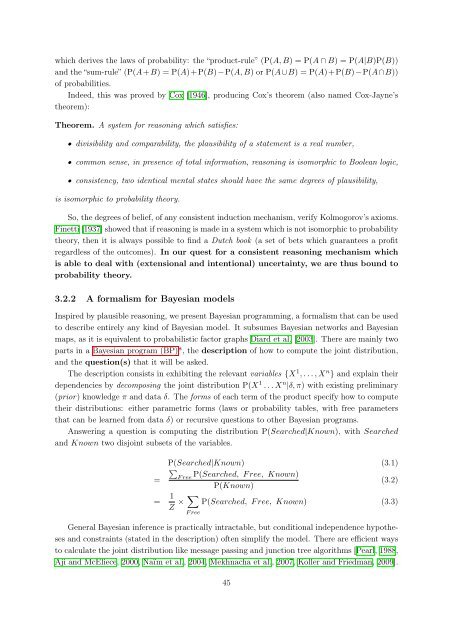Bayesian Programming and Learning for Multi-Player Video Games ...
Bayesian Programming and Learning for Multi-Player Video Games ...
Bayesian Programming and Learning for Multi-Player Video Games ...
You also want an ePaper? Increase the reach of your titles
YUMPU automatically turns print PDFs into web optimized ePapers that Google loves.
which derives the laws of probability: the “product-rule” (P(A, B) = P(A ∩ B) = P(A|B)P(B))<br />
<strong>and</strong> the “sum-rule” (P(A+B) = P(A)+P(B)−P(A, B) or P(A∪B) = P(A)+P(B)−P(A∩B))<br />
of probabilities.<br />
Indeed, this was proved by Cox [1946], producing Cox’s theorem (also named Cox-Jayne’s<br />
theorem):<br />
Theorem. A system <strong>for</strong> reasoning which satisfies:<br />
• divisibility <strong>and</strong> comparability, the plausibility of a statement is a real number,<br />
• common sense, in presence of total in<strong>for</strong>mation, reasoning is isomorphic to Boolean logic,<br />
• consistency, two identical mental states should have the same degrees of plausibility,<br />
is isomorphic to probability theory.<br />
So, the degrees of belief, of any consistent induction mechanism, verify Kolmogorov’s axioms.<br />
Finetti [1937] showed that if reasoning is made in a system which is not isomorphic to probability<br />
theory, then it is always possible to find a Dutch book (a set of bets which guarantees a profit<br />
regardless of the outcomes). In our quest <strong>for</strong> a consistent reasoning mechanism which<br />
is able to deal with (extensional <strong>and</strong> intentional) uncertainty, we are thus bound to<br />
probability theory.<br />
3.2.2 A <strong>for</strong>malism <strong>for</strong> <strong>Bayesian</strong> models<br />
Inspired by plausible reasoning, we present <strong>Bayesian</strong> programming, a <strong>for</strong>malism that can be used<br />
to describe entirely any kind of <strong>Bayesian</strong> model. It subsumes <strong>Bayesian</strong> networks <strong>and</strong> <strong>Bayesian</strong><br />
maps, as it is equivalent to probabilistic factor graphs Diard et al. [2003]. There are mainly two<br />
parts in a <strong>Bayesian</strong> program (BP)*, the description of how to compute the joint distribution,<br />
<strong>and</strong> the question(s) that it will be asked.<br />
The description consists in exhibiting the relevant variables {X 1 , . . . , X n } <strong>and</strong> explain their<br />
dependencies by decomposing the joint distribution P(X 1 . . . X n |δ, π) with existing preliminary<br />
(prior) knowledge π <strong>and</strong> data δ. The <strong>for</strong>ms of each term of the product specify how to compute<br />
their distributions: either parametric <strong>for</strong>ms (laws or probability tables, with free parameters<br />
that can be learned from data δ) or recursive questions to other <strong>Bayesian</strong> programs.<br />
Answering a question is computing the distribution P(Searched|Known), with Searched<br />
<strong>and</strong> Known two disjoint subsets of the variables.<br />
=<br />
P(Searched|Known) (3.1)<br />
�<br />
F ree<br />
P(Searched, F ree, Known)<br />
P(Known)<br />
(3.2)<br />
= 1 �<br />
× P(Searched, F ree, Known) (3.3)<br />
Z<br />
F ree<br />
General <strong>Bayesian</strong> inference is practically intractable, but conditional independence hypotheses<br />
<strong>and</strong> constraints (stated in the description) often simplify the model. There are efficient ways<br />
to calculate the joint distribution like message passing <strong>and</strong> junction tree algorithms [Pearl, 1988,<br />
Aji <strong>and</strong> McEliece, 2000, Naïm et al., 2004, Mekhnacha et al., 2007, Koller <strong>and</strong> Friedman, 2009].<br />
45


